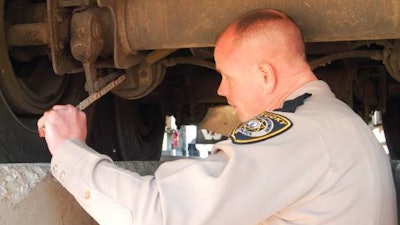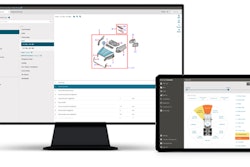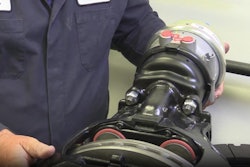
More than 5,000 trucks were placed out of service during the Commercial Vehicle Safety Alliance (CVSA) Brake Safety Week in 2022.
In the hopes of reducing that number this year, Bendix Commercial Vehicle Systems has released a list of practical tips for being prepared, staying safe and passing inspection that truck owners and service providers can use ahead of Brake Safety Week 2023, set for Aug. 20-26.
“Out-of-service violations are situations that present actual hazards to roadway safety for the drivers and everyone around them – and so many of these violations are preventable through proper maintenance practices and regular equipment examination,” says Fred Andersky, Bendix director – demos, sales, and service training. “Brake Safety Week is an industry touchpoint for good reason: What goes on at the wheel-ends and in the braking system is critical to so many aspects of safe vehicle operation, including optimal performance of today’s higher-level safety systems like full stability and collision mitigation. You simply can’t overstate the importance of keeping up with maintenance and inspection of those areas.”
[RELATED: Troubleshooting brake imbalance in Class 8 trucks]
Brake Safety Week is part of CVSA’s Operation Airbrake initiative — an outreach and enforcement campaign that aims to reduce the number of highway crashes caused by faulty brake systems on commercial motor vehicles. The event involves local, state, provincial, territorial, and federal motor carrier safety officials in the United States, Canada, and Mexico inspecting large trucks and buses, focusing on brake system violations.
Last year the 5,059 trucks placed out of service represented 13.3% of the 38,117 commercial motor vehicles inspected across the United States, Canada, and Mexico during the annual weeklong event.
Brake Safety Week roadside inspectors conduct North American Standard Inspections, which cover a range of driver qualifications, documentation, and vehicle equipment conditions. Trucks will be checking for:
- Missing, nonfunctioning, loose, or cracked parts
- Holes caused by rust and through rubbing or friction
- Broken springs in the spring brake housing section of the parking brake
- Air leaks around brake components and lines
- Air pressure in the target range of 90-100 psi
- Proper pushrod travel
- Slack adjusters not at the same length
- Mismatched air chamber sizes across axles
- Warning device functionality (such as antilock braking system indicator lights)
- Proper operation of the tractor protection system, including the bleed-back system on the trailer
- The breakaway system being operable on the trailer
Inspectors will also keep a special eye out for contaminated, worn, cracked, and missing linings or pads, the focus of this year’s Brake Safety Week. To prepare for those inspections, Bendix offers several tips.
“What you do in the shop and during pre-trip walk-arounds – looking at every aspect of your vehicle – can make an important difference on the road and during a brake system inspection, simply by catching brake-related issues before they become problems,” says Mark Holley, Bendix director of marketing and customer solutions, Wheel-End. “Your regular inspections can go a long way toward catching some obvious violations, including loose hoses or damaged components like air chambers or pushrods.”
Holley's recommendations include daily, weekly and monthly inspections.
Daily:
- Check for damaged or loose-hanging air chambers, pushrods, or slack adjusters.
- Make sure slack adjusters on each axle are extended out to the same angle. Different angles can indicate an out-of-adjustment brake or a broken spring brake power spring.
- Examine tubing and hose condition, positioning, and connections.
Every week:
- Perform a 90- to 100-psi brake application with the wheels chocked and the parking brakes released, and listen for leaks.
- Check air disc brake rotors for cracks.
- Inspect drum brake linings for wear and cracks.
Every month:
- Check for moisture in the air system to prevent contamination that leads to component deterioration and system leaks.
Additionally, any time you’ve got a vehicle in the shop, it’s also worth greasing the S-cam brake tubes and automatic slack adjusters. This quick process helps prevent rust and corrosion, and it helps keep the slack functioning properly.
Bendix also notes air disc brakes and drum brakes have a few differing maintenance needs where Brake Safety Week is concerned – key among them the measurement of brake stroke. Because air disc brakes include an internal adjustment mechanism, their brake stroke is not measured externally, as is the case with drum brakes.
“Measuring a drum brake’s chamber stroke is a matter of checking the distance from the air chamber to the clevis pin with the brakes released, and then again after a fully charged brake application,” Holley says. “The difference between these measurements is the brake stroke, and its maximum length depends upon the brake chamber type and size.”
Improperly adjusted brakes can also drag, impacting fuel efficiency and speeding up pad wear, or experience decreased stopping power. Bendix has developed an infographic (below) to note the differing maintenance needs of air disc and drum brakes.

“When it’s time to replace a component in your brake system, whether it’s at the wheel-end or in the air supply, be sure to select parts that won’t degrade the performance level or bring it below the original equipment manufacturer’s standards,” Holley says. “This selection is particularly true when it comes to brake friction, where the aftermarket is more crowded than ever, and the wrong choice can actually harm your system and your vehicle safety.”
Bendix says not all replacement linings that are marketed as acceptable for federal stopping distance requirements will actually perform to the standard. Other complications arising from improper friction selection can include cracks, degradation of braking performance, or damage to other wheel-end components. Remember, these issues are things that a roadside inspector will note and penalize truck owners for.
“Whether you’re replacing air disc brake pads or drum brake shoes, select components that will ensure the original equipment manufacturer (OEM) requirements are met so the vehicle remains compliant,” Holley says.










